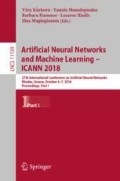Abstract
The heavy storage and computational overheads have become a hindrance to the deployment of modern Convolutional Neural Networks (CNNs). To overcome this drawback, many works have been proposed to exploit redundancy within CNNs. However, most of them work as post-training processes. They start from pre-trained dense models and apply compression and extra fine-tuning. The overall process is time-consuming. In this paper, we introduce redundancy-aware training, an approach to learn sparse CNNs from scratch with no need for any post-training compression procedure. In addition to minimizing training loss, redundancy-aware training prunes unimportant weights for sparse structures in the training phase. To ensure stability, a stage-wise pruning procedure is adopted, which is based on carefully designed model partition strategies. Experiment results show redundancy-aware training can compress LeNet-5, ResNet-56 and AlexNet by a factor of \(43.8\times \), \(7.9\times \) and \(6.4\times \), respectively. Compared to state-of-the-art approaches, our method achieves similar or higher sparsity while consuming significantly less time, e.g., 2.3\(\times \)–18\(\times \) more efficient in terms of time.
Access this chapter
Tax calculation will be finalised at checkout
Purchases are for personal use only
References
Alvarez, J.M., Salzmann, M.: Compression-aware training of deep networks. In: Advances in Neural Information Processing Systems, pp. 856–867 (2017)
Denil, M., Shakibi, B., Dinh, L., de Freitas, N., et al.: Predicting parameters in deep learning. In: Advances in Neural Information Processing Systems, pp. 2148–2156 (2013)
Girshick, R.B.: Fast R-CNN. In: 2015 IEEE International Conference on Computer Vision, ICCV 2015, Santiago, Chile, 7–13 December 2015, pp. 1440–1448 (2015)
Guo, Y., Yao, A., Chen, Y.: Dynamic network surgery for efficient DNNs. In: Advances in Neural Information Processing Systems, pp. 1379–1387 (2016)
Han, S., Mao, H., Dally, W.J.: Deep compression: Compressing deep neural networks with pruning, trained quantization and Huffman coding. In: Proceedings of the International Conference on Learning Representations, ICLR (2016)
He, K., Gkioxari, G., Dollár, P., Girshick, R.B.: Mask R-CNN. In: IEEE International Conference on Computer Vision, pp. 2980–2988 (2017)
He, K., Zhang, X., Ren, S., Sun, J.: Deep residual learning for image recognition. In: Proceedings of the IEEE Conference on Computer Vision and Pattern Recognition, pp. 770–778 (2016)
He, Y., Zhang, X., Sun, J.: Channel pruning for accelerating very deep neural networks. In: Proceedings of the IEEE Conference on Computer Vision and Pattern Recognition, pp. 1389–1397 (2017)
Jia, Y., et al.: Caffe: convolutional architecture for fast feature embedding. In: Proceedings of the 22nd ACM International Conference on Multimedia, pp. 675–678. ACM (2014)
Kim, E., Ahn, C., Oh, S.: Learning nested sparse structures in deep neural networks. arXiv preprint arXiv:1712.03781 (2017)
Krizhevsky, A., Sutskever, I., Hinton, G.E.: ImageNet classification with deep convolutional neural networks. In: Advances in Neural Information Processing Systems, pp. 1097–1105 (2012)
LeCun, Y., Bottou, L., Bengio, Y., Haffner, P.: Gradient-based learning applied to document recognition. Proc. IEEE 86(11), 2278–2324 (1998)
Li, H., Kadav, A., Durdanovic, I., Samet, H., Graf, H.P.: Pruning filters for efficient ConvNets. In: Proceedings of the International Conference on Learning Representations, ICLR (2017)
Louizos, C., Welling, M., Kingma, D.P.: Learning sparse neural networks through \( l\_0 \) regularization. In: Proceedings of the International Conference on Learning Representations, ICLR (2018)
Srinivas, S., Babu, R.V.: Learning neural network architectures using backpropagation. In: Proceedings of the British Machine Vision Conference. BMVA Press (2016)
Srinivas, S., Subramanya, A., Babu, R.V.: Training sparse neural networks. In: 2017 IEEE Conference on Computer Vision and Pattern Recognition Workshops, CVPR Workshops, pp. 455–462 (2017)
Wen, W., Wu, C., Wang, Y., Chen, Y., Li, H.: Learning structured sparsity in deep neural networks. In: Advances in Neural Information Processing Systems, pp. 2074–2082 (2016)
Yu, R., et al.: NISP: pruning networks using neuron importance score propagation. arXiv preprint arXiv:1711.05908 (2017)
Acknowledgments
This work is supported by National Key R&D Program of China under Grant No. 2017YFB0202002, Science Fund for Creative Research Groups of the National Natural Science Foundation of China under Grant No. 61521092 and the Key Program of National Natural Science Foundation of China under Grant Nos. 61432018, 61332009, U1736208.
Author information
Authors and Affiliations
Corresponding author
Editor information
Editors and Affiliations
Rights and permissions
Copyright information
© 2018 Springer Nature Switzerland AG
About this paper
Cite this paper
Dong, X., Liu, L., Li, G., Zhao, P., Feng, X. (2018). Fast CNN Pruning via Redundancy-Aware Training. In: Kůrková, V., Manolopoulos, Y., Hammer, B., Iliadis, L., Maglogiannis, I. (eds) Artificial Neural Networks and Machine Learning – ICANN 2018. ICANN 2018. Lecture Notes in Computer Science(), vol 11139. Springer, Cham. https://doi.org/10.1007/978-3-030-01418-6_1
Download citation
DOI: https://doi.org/10.1007/978-3-030-01418-6_1
Published:
Publisher Name: Springer, Cham
Print ISBN: 978-3-030-01417-9
Online ISBN: 978-3-030-01418-6
eBook Packages: Computer ScienceComputer Science (R0)

